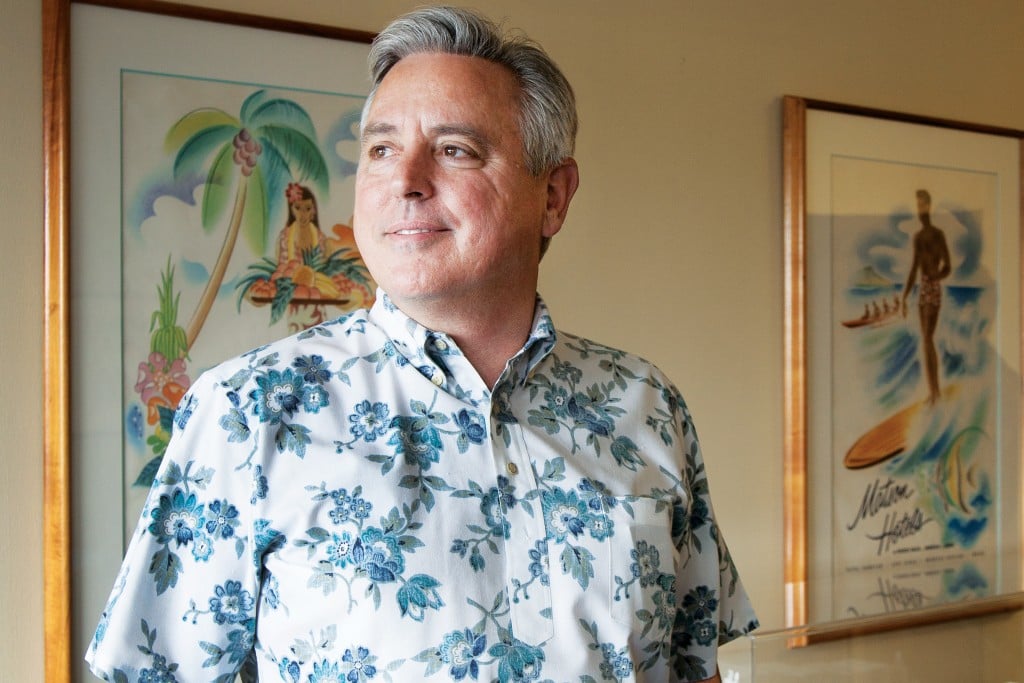Talk Story with Matt Cox, CEO of Matson

Why did Alexander & Baldwin andMatson stick together so long, and why did they finally decide to separate?
There was always a great story about why these companies ended up together. A&B was a landowner and an agricultural company, and needed a way to get its sugar from its operations to the West Coast. What investors always said was, “Yes, that’s interesting, but why are you still together?” The reality was that, for the longest time, both businesses benefited from the strengths that the other business brought. A&B benefited from Matson’s relatively predictable cash flows, and Matson benefited from being able to move products back and forth on Alexander & Baldwin’s behalf. Also, the thinking was that, as a group, we were a larger company and could therefore have more ready access to capital.
What changed?
The belief was that Matson could always have been run as an independent company, but the real estate operations were arguably not of a sufficient size, with predictable cash flows, to be able to stand on their own. … Over the decades, through a very focused period of growth on the real estate side, that business grew to a size that would allow separation to occur. That decision was made Dec. 1, 2011. …
So, each business could pursue its own strategic interests better on its own. Each company would be more focused. Each company had its own economic cycles and investment periods. And each could attract its own investors, who were interested in investing in either a real-estate-development and agriculture company, or in a transportation company.
Will there be any structural changes that will impact Hawaii?
A&B operated Matson as an independent business. So, whether it was our corporate strategies our vessel renewal plans, or our overall growth strategy – those have remained virtually unchanged since separation. What I will say – and I think this is true for A&B as well – is that we feel more focused on fulfilling our own business purpose and mission. I think we’re excited to be on our own, to be accountable to shareholders directly. So, we see it as a positive for both companies. But, as it relates to strategy or structural things, there really haven’t been any changes. For the person running the terminal here, or our sales and marketing efforts, or our fleet operations, it’s business as usual.
How do you know if the separation is “working”?
One of the ways we measure that is by looking at what the stock was trading at immediately before the announcement, and what it’s trading at today to see how investors who held A&B stock benefited. I don’t have the exact quote from Nov. 30, 2011, but it was just under $40 a share. Today, post separation, if you look at both companies, they’re trading at a combined price of $56 a share. So, there was a substantial benefit to the holders of Alexander & Baldwin stock, which is, in part, a reflection of the fact that the market liked the idea of the businesses operating separately.
Speaking of the market, how has the investment community reacted to the separation?
I think it’s been good. We’ve picked up additional coverage from equity analysts that are purely focused on transportation. Before, they knew of Matson, but, because we were part of a real estate group that they were not familiar with, they chose to not cover us as a separate transportation company. So, I would say we’ve attracted additional coverage, which is one of the things we hoped would happen after the separation. More investors will learn about us, hear our story.
I will say, though, while Matson is a new independent equity, we were already pretty well known by these transportation analysts. They just didn’t know what to make of the real estate business. And, in fairness, the same is true for the real estate analysts. They would say, “Okay, I get cap rates. I get that A&B is a savvy real estate investor. But I have no idea how to figure out how this transportation company is doing. So, again, that was part of the strategy around the separation: to allow for a more focused investor to be able to understand the company better.
You were the COO of Matson before the separation. How has your job changed since the separation?
Well, I was in charge of running Matson, so my job has changed only with respect to a few things. Effectively, before the separation, I ran Matson and reported to Stan Kuriyama, the CEO of A&B. What I didn’t do before was: we didn’t have our own SEC reporting – that was done through A&B. We didn’t deal directly with investors or shareholders. I was active in meetings with investors, as part of the A&B management team. We’d go to New York and often meet with investors, but not on our own. So, that has changed. And then, I’m spending more time managing the board and those things that are required when you run a publicly traded company: shareholder meetings, preparing for quarterly earnings calls, overseeing and conducting the SEC reporting, and those kinds of things. That part of my job is new. The rest of my job, the day-to-day running of the company, has not changed.





